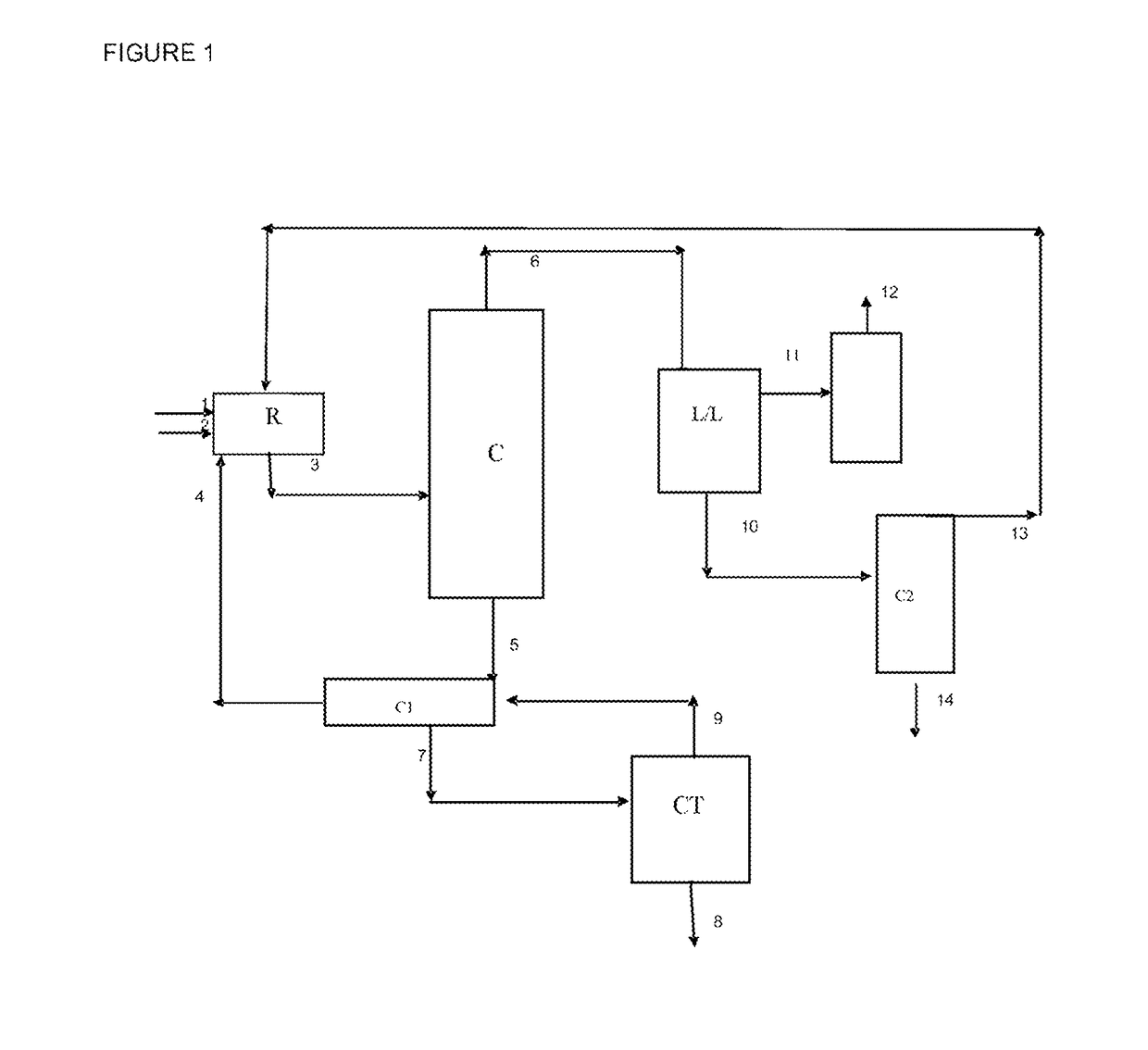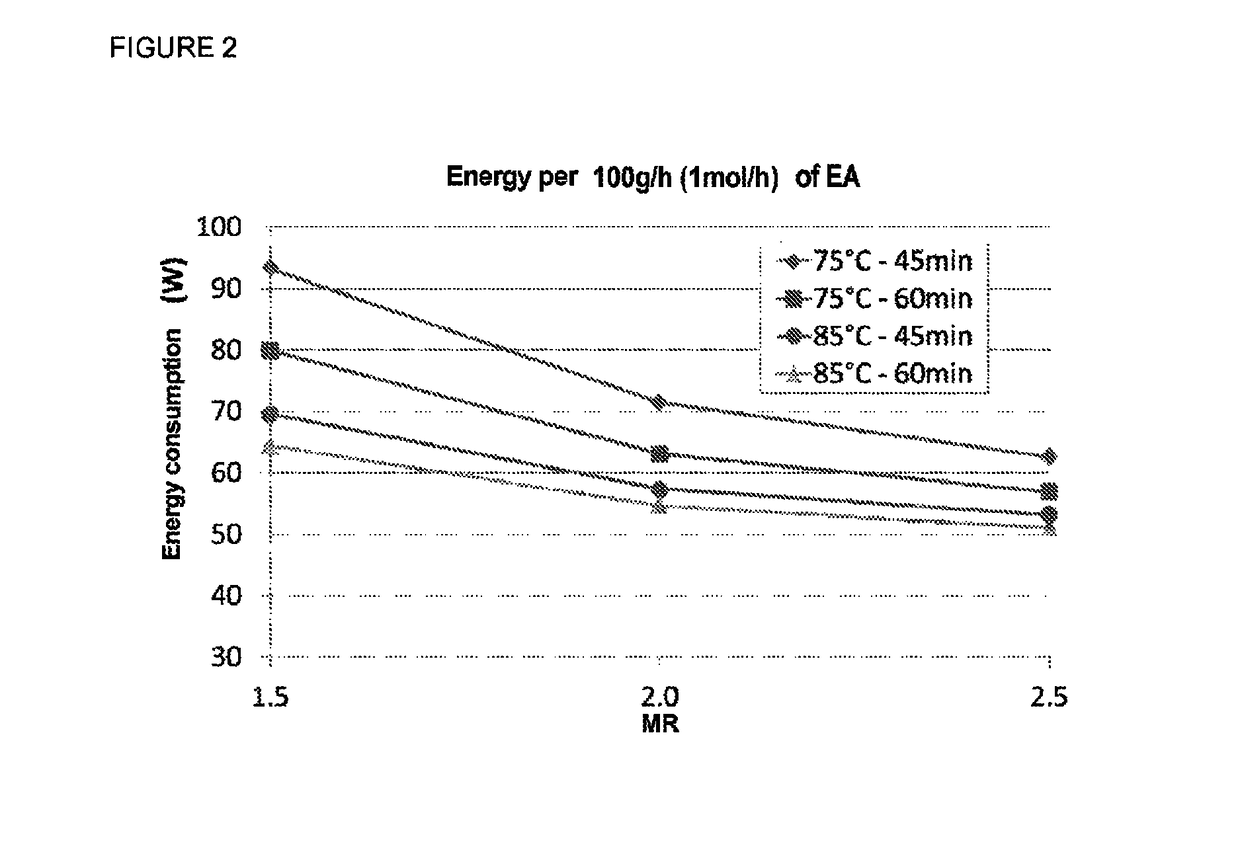Process for producing light (meth)acrylic esters
a technology of acrylic esters and acrylic esters, which is applied in the preparation of carboxylic compounds, carbonyl compounds, carboxylic acid esters, etc., can solve the problems of low efficiency, low final residue value, and relatively complex treatment process
- Summary
- Abstract
- Description
- Claims
- Application Information
AI Technical Summary
Benefits of technology
Problems solved by technology
Method used
Image
Examples
example 1
[0070]Tests for synthesizing ethyl acrylate were carried out using a reactor 2.5 cm in diameter, 55 cm high and with a volume of 270 ml. The reactor is filled with 330 ml of K1431 resin (LANXESS). Before being placed in the reactor, the resin (330 ml) was conditioned in the reaction mixture, leading to a reduction in volume by replacing the water in its structure with the reagents present in the reaction mixture.
[0071]The reagents are introduced at the top of the reactor via a pump. They may be preheated to the reaction temperature. At the bottom of the reactor there is a condenser which cools the reaction mixture by virtue of a calender fed with water. The pressure is regulated by acting on a regulating valve placed at the outlet of the condenser.
[0072]The reaction mixture is stabilized with 1000 ppm of hydroquinone and placed under stirring. To take account of the streams derived from recycling operations, the reactor was fed with a synthetic mixture comprising, in weight %:
[0073]...
example 2
Acid / Alcohol Mole Ratio on the Formation of Ethyl Ethoxypropionate
[0096]To illustrate the beneficial effect of the excess of acrylic acid on the formation of EEP, comparative tests were carried out in the same equipment as used in example 1, with a K1431 resin volume of 206 ml, a reaction temperature of 75° C. at a pressure of 1.3 bar and a residence time of 110 mins.
[0097]Table 4 below shows the beneficial effect of the AA / EtOH mole ratio on reducing the formation of EEP. The negative effect of a residence time greater than one hour for the formation of EEP is also observed (compared to the results from table 3 obtained with shorter residence times).
[0098]
TABLE 4AA / EtOHTemperatureResidence timeEEPMole ratio(° C.)(min)(kg / t)2.375110191.47511020 1 (comp)7511022.60.8 (comp)75110240.5 (comp)75110280.19 (comp) 7511035
example 3
Water on Process Productivity
[0099]Tests for synthesizing ethyl acrylate were carried out under the same conditions as those from example 1, with a feed stream composed, in weight %, of 0.5 to 6% of water, 65%-75% of acrylic acid, 20-28% of ethanol, 0 to 3% of ethyl acrylate and impurities such as ethyl acetate (45 ppm), acetic acid and hydroquinone in an amount of 1000 ppm.
[0100]The water content was varied so as to simulate an at least partially dehydrated stream for feeding the reactor.
[0101]In these tests, the reaction temperature is 75° C. and the residence time in the reactor is 45 mins.
[0102]The results of the tests are collated in table 5 below.
[0103]
TABLE 5TotalAdducts withSelectivitySelectivityadductsrecoverableETOHfor EAfor EAAA / EtOH(g / 100 gvalueconversionrelative torelative tomole ratioH2O %EA %EA)(%)(%)EtOH (%)AA (%)2.50.602.226762.5302.526699797.52.55.702.723612132.1176997.998.3
[0104]In these conditions, when the water content in the feed stream of the esterification r...
PUM
| Property | Measurement | Unit |
|---|---|---|
| pressure | aaaaa | aaaaa |
| mole ratio | aaaaa | aaaaa |
| mole ratio | aaaaa | aaaaa |
Abstract
Description
Claims
Application Information
 Login to View More
Login to View More - R&D
- Intellectual Property
- Life Sciences
- Materials
- Tech Scout
- Unparalleled Data Quality
- Higher Quality Content
- 60% Fewer Hallucinations
Browse by: Latest US Patents, China's latest patents, Technical Efficacy Thesaurus, Application Domain, Technology Topic, Popular Technical Reports.
© 2025 PatSnap. All rights reserved.Legal|Privacy policy|Modern Slavery Act Transparency Statement|Sitemap|About US| Contact US: help@patsnap.com


